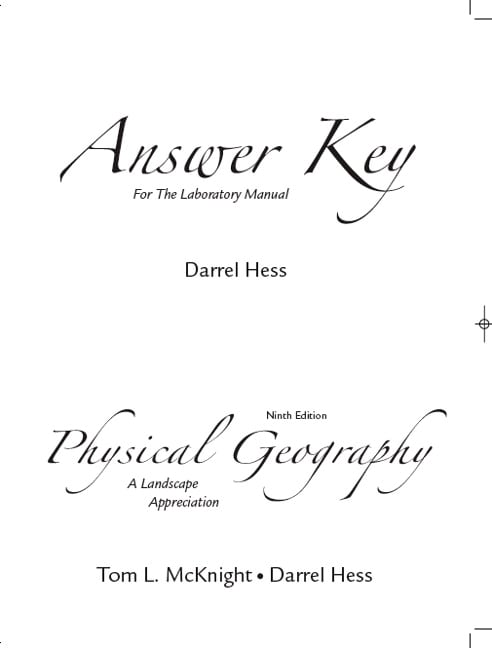. Extensive instructor and student resources include the companion website for the lab manual, GeoTools templates (rulers, protractors, mapping tools, sediment grain size scale, etc.), and a variety of instructor resources. Outstanding visual clarity and appeal are found throughout the lab manual in high-quality photographs, images, stereograms, maps, and charts.
Laboratory Manual In Physical Geology Key
INSTRUCTOR S RESOURCE GUIDE Richard M. Busch West Chester University of Pennsylvania LABORATORY MANUAL IN PHYSICAL GEOLOGY NINTH EDITION Produced under the auspices of the.
Emphasis on GPS (Global Positioning System) and UTM (Universal Transverse Mercator grid datum) introduces students to these topics and their application in navigation, mapping, and geology. Hands-on experimental labs are provided. GeoTools provides students with rulers, protractors, sediment grain-size scales, UTM grids, and other laboratory tools on transparent cut-out sheets in the back of the manual. A math conversion chart, explanation of measurement units, and illustrations of lab equipment are provided in the Preface. An activity-based approach: All labs have been reorganized into a new format that focuses on labs as Activities, complete with tear-out activity sheets rather than lists of questions.
• Have students read the specific ideas aloud and emphasize one important word for each. Standard Met CCSS.ELA-Literacy.RI.6.4 Go Your Own Way What you need • from first activity • Highlighters, markers, or colored pencils What to do • Personalizing notes (emphasizing important words, adding pictures) helps students learn and remember information more easily.  Have kids read the title written on their T-charts aloud, then choose one or two words to highlight or circle.
Have kids read the title written on their T-charts aloud, then choose one or two words to highlight or circle.

The Activities provide firsthand experiences that are designed to appeal to multiple types of student learning and focus on development of both skills and geologic content. Activities are designed for students to build skills (e.g., observing, investigating, measuring, recording data, charting, graphing, mapping); apply skills and knowledge to analyze and evaluate samples, data, maps, models, and images; and record data/results and inferences. Tear-out activity sheets are provided in the lab manual separate from significant text, figures, and other supporting lab manual content that students will need to for future study and use of the manual. Instructors save time, resources, and money, because they no longer need to design, photocopy, and hand out activity sheets. A completely revised art program and design includes new high-quality photographs, images, stereograms, maps, and charts. Enhanced premium website found at www.mygeoscienceplace.com will provide students and instructors with additional learning tools. About the Author(s) Richard M.


Busch is a Professor of Geology at West Chester University of Pennsylvania. He holds degrees in geology from Franklin & Marshall College (A.B.), Temple University (M.A.), and University of Pittsburgh (PhD) and has published scholarly work in both geology and geoscience education. For the past 30 years he has been teaching geology to undergraduate majors and non-majors. For the past 22 years he has been teaching classes on science teaching methods for majors in elementary and secondary education. He also has work experience as a hydrogeologist, museum educator, and consultant on stratigraphy and science education. His work as Editor of the AGI-NAGT Lab Manual in Physical Geology spans eight editions over 22 years, during which time he has also been involved in the in the development of K-16 textbooks and ancillary products.